Results for On display?:on; Current location:UMMA Gallery Location ➔ FFW, Mezzanine ➔ M07 (Woon-hyung Lee and Korea Foundation Gallery of Korean Art)
56 UMMA Objects
56 UMMA Objects
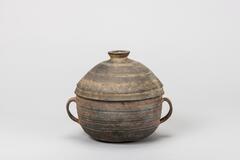
Korean (Korean (culture or style))
Two-handled bowl with cover
400 – 599
Gift of Bruce and Inta Hasenkamp and Museum purchase made possible by Elder and Mrs. Sang-Yong Nam
2004/1.182A&B
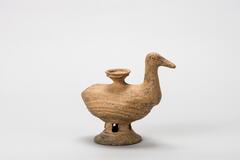
Korean (Korean (culture or style))
Vessel in the shape of a duck
200 – 399
Gift of Bruce and Inta Hasenkamp and Museum purchase made possible by Elder and Mrs. Sang-Yong Nam
2004/1.188
![<p>This type of bowls was produced in the 12th century when the production of celadon was increased. is piece is assumed to be a product of a kiln in Sadang-ri, Gangjin-gun, Jeollanam-do. e outer wall is decorated with incised and raised deisgn of a two- tiered lotus petal. The bowl was entirely glazed including the rim of the foot. e outer base retains three white quartzite spur marks. e glaze is fused well, displaying a ne gloss, but parts of it have been oxidized to tinge the inner surface with yellow.<br />
[<em>Korean Collection, University of Michigan Museum of Art </em>(2014) p.102]</p>
<p>This type of bowls was produced in the 12th century when the production of celadon was increased. is piece is assumed to be a product of a kiln in Sadang-ri, Gangjin-gun, Jeollanam-do. e outer wall is decorated with incised and raised deisgn of a two- tiered lotus petal. The bowl was entirely glazed including the rim of the foot. e outer base retains three white quartzite spur marks. e glaze is fused well, displaying a ne gloss, but parts of it have been oxidized to tinge the inner surface with yellow.<br />
[<em>Korean Collection, University of Michigan Museum of Art </em>(2014) p.102]</p>](/media/W1siZiIsIjIwMjIvMDkvMjQvOWVvOXU2emZncV9kZWZhdWx0LmpwZyJdLFsicCIsInRodW1iIiwiMjQweDIwMCJdXQ?sha=413a02bc2a8a0993)
Korean (Korean (culture or style))
Bowl with carved lotus design
12th century
Gift of Bruce and Inta Hasenkamp and Museum purchase made possible by Elder and Mrs. Sang-Yong Nam
2004/1.231
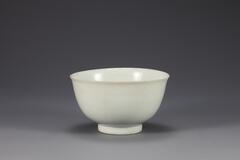
Korean (Korean (culture or style))
Deep Bowl
15th century
Gift of Bruce and Inta Hasenkamp and Museum purchase made possible by Elder and Mrs. Sang-Yong Nam
2004/1.265
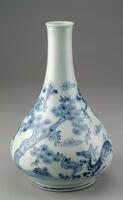
Korean (Korean (culture or style))
Wine bottle with Ten Symbols of Longevity design
19th century
Gift of Bruce and Inta Hasenkamp and Museum purchase made possible by Elder and Mrs. Sang-Yong Nam
2004/1.281
![A round water dropper in the shape of a curled fish. There are two holes, one located in the middle, near the tail fin, and the other near the head on the dorsal fin. The fish is a white and cobalt blue color.<br />
<br />
This is a carp-shaped water dropper produced within the vicinity of Bunwon-ri, Gwangju-si, and Yeoju-si area in Gyeonggi-do in the late 19th century. Its upper surface features a realistic carp design in relief and entirely colored with cobalt blue. Such animal-shaped vessels are simple in form, but they were esteemed by many for their auspicious meaning. The base is flat, wide, and stained by ink.<br />
[Korean Collection, University of Michigan Museum of Art (2014) p.184] A round water dropper in the shape of a curled fish. There are two holes, one located in the middle, near the tail fin, and the other near the head on the dorsal fin. The fish is a white and cobalt blue color.<br />
<br />
This is a carp-shaped water dropper produced within the vicinity of Bunwon-ri, Gwangju-si, and Yeoju-si area in Gyeonggi-do in the late 19th century. Its upper surface features a realistic carp design in relief and entirely colored with cobalt blue. Such animal-shaped vessels are simple in form, but they were esteemed by many for their auspicious meaning. The base is flat, wide, and stained by ink.<br />
[Korean Collection, University of Michigan Museum of Art (2014) p.184]](/media/W1siZiIsIjIwMjIvMDkvMjQvNDI4bnhsZWJzcF9kZWZhdWx0LmpwZyJdLFsicCIsInRodW1iIiwiMjQweDIwMCJdXQ?sha=526177d522caf151)
Korean (Korean (culture or style))
Blue-and-White Water Dropper in the Shape of a Fish
1867 – 1899
Gift of Bruce and Inta Hasenkamp and Museum purchase made possible by Elder and Mrs. Sang-Yong Nam
2004/1.286
![It is a knife made of silver. The sword blade was made of steel. Floral design was printed on the knob and Deer and bamboo was printed on the cover.<br />
<br />
This small knife is worn by a man. The handle and sheath are decorated with ten symbols of longevity against ring-punched background. The other side features engravings of plantains and lotus buds. Plantain symbolizes resuscitation from death and is one of the Eight Treasures of Taoism. The lotus flower symbolizes purity and the law of cause and effect as it emerges from mud (dirt) and bears seeds.
<p>[Korean Collection, University of Michigan Museum of Art (2017) p. 285]</p>
<br />
It is a knife made of silver. The sword blade was made of steel. Floral design was printed on the knob and Deer and bamboo was printed on the cover.<br />
<br />
This small knife is worn by a man. The handle and sheath are decorated with ten symbols of longevity against ring-punched background. The other side features engravings of plantains and lotus buds. Plantain symbolizes resuscitation from death and is one of the Eight Treasures of Taoism. The lotus flower symbolizes purity and the law of cause and effect as it emerges from mud (dirt) and bears seeds.
<p>[Korean Collection, University of Michigan Museum of Art (2017) p. 285]</p>
<br />
](/media/W1siZiIsIjIwMjIvMDUvMjUvMmU1d2t5c3F5dF9kZWZhdWx0LmpwZyJdLFsicCIsInRodW1iIiwiMjQweDIwMCJdXQ?sha=205dc80a7c1c10b6)
Korean (Korean (culture or style))
Ladies Knife
19th century
Museum purchase made possible by the Margaret Watson Parker Art Collection Fund
1985/2.48
![This bright grayish-blue stoneware jar consists of a round base, globular body and long flaring neck. Narrow single ridges encircle the middle part of the neck, dividing it into four sections. Each section is engraved with a wave pattern. The shoulder doesn’t have any pattern.<br />
<br />
This is a blue-gray, long-necked, high-fired stoneware jar. The horizontal ridge on the upper part of the long vessel neck marks the boundary between the neck and its inwardly curved mouth. The mouth slopes inward and has a sharp edge. The neck is divided into four sections by three horizontal ridges spaced at equal intervals, and each section is decorated by a wave design rendered with a comb with approximately ten teeth. The jar is widest at its upper-middle part, and the base is round with a slightly recessed center.<br />
[Korean Collection, University of Michigan Museum of Art (2017) p. 47]<br />
This bright grayish-blue stoneware jar consists of a round base, globular body and long flaring neck. Narrow single ridges encircle the middle part of the neck, dividing it into four sections. Each section is engraved with a wave pattern. The shoulder doesn’t have any pattern.<br />
<br />
This is a blue-gray, long-necked, high-fired stoneware jar. The horizontal ridge on the upper part of the long vessel neck marks the boundary between the neck and its inwardly curved mouth. The mouth slopes inward and has a sharp edge. The neck is divided into four sections by three horizontal ridges spaced at equal intervals, and each section is decorated by a wave design rendered with a comb with approximately ten teeth. The jar is widest at its upper-middle part, and the base is round with a slightly recessed center.<br />
[Korean Collection, University of Michigan Museum of Art (2017) p. 47]<br />
](/media/W1siZiIsIjIwMjIvMDkvMjQvM2M4cmF2ZmJ5OV9kZWZhdWx0LmpwZyJdLFsicCIsInRodW1iIiwiMjQweDIwMCJdXQ?sha=62bb2075b9e5bebe)
Korean (Korean (culture or style))
Storage jar with bands of incised wavy patterns at neck; lid missing
5th century
Museum purchase made possible by the Margaret Watson Parker Art Collection Fund
2003/1.384
![It looks like a rescent, animal's tooth or fetus. There is a hole and some carved line on the head part.<br />
<br />
This is a comma-shaped bead made from dark green jade. Such crescent moon-shaped beads, referred to as<em> gogok</em>, were used to decorate golden crowns, clothing, and belts. This example, which was attached to other ornaments via the hole in its head, is typical of comma-shaped beads of the Three Kingdoms period. Three parallel lines are incised across the hole, from which four more incised lines radiate upwards.<br />
[Korean Collection, University of Michigan Museum of Art (2017) p.33] It looks like a rescent, animal's tooth or fetus. There is a hole and some carved line on the head part.<br />
<br />
This is a comma-shaped bead made from dark green jade. Such crescent moon-shaped beads, referred to as<em> gogok</em>, were used to decorate golden crowns, clothing, and belts. This example, which was attached to other ornaments via the hole in its head, is typical of comma-shaped beads of the Three Kingdoms period. Three parallel lines are incised across the hole, from which four more incised lines radiate upwards.<br />
[Korean Collection, University of Michigan Museum of Art (2017) p.33]](/media/W1siZiIsIjIwMjIvMDUvMjUvNXUwNHN1cTN0Y19kZWZhdWx0LmpwZyJdLFsicCIsInRodW1iIiwiMjQweDIwMCJdXQ?sha=70118906356121f7)
Korean (Korean (culture or style))
Comma-shaped Pendant
400 – 599
Museum purchase made possible by the Margaret Watson Parker Art Collection Fund
1983/1.152
![It has a flared mouth. The side is tapering gently down to the base. It was brushed with white slip interior and outerior sides.<br />
<br />
Bowls of this kind were commonly used as burial accessories in the 15th century Joseon; many have been excavated. This bowl has been rapidly spun and brush-painted with white slip on its inner and outer surfaces. The large amount of sand mixed with the clay has produced a rough texture. Traces of clay supports remain on both the inner base and the rim of foot, indicating that this bowl was stacked among other bowls while separated by clay spurs during firing. The glaze was fused well, producing a glossy surface.<br />
[Korean Collection, University of Michigan Museum of Art (2014) p.155] It has a flared mouth. The side is tapering gently down to the base. It was brushed with white slip interior and outerior sides.<br />
<br />
Bowls of this kind were commonly used as burial accessories in the 15th century Joseon; many have been excavated. This bowl has been rapidly spun and brush-painted with white slip on its inner and outer surfaces. The large amount of sand mixed with the clay has produced a rough texture. Traces of clay supports remain on both the inner base and the rim of foot, indicating that this bowl was stacked among other bowls while separated by clay spurs during firing. The glaze was fused well, producing a glossy surface.<br />
[Korean Collection, University of Michigan Museum of Art (2014) p.155]](/media/W1siZiIsIjIwMjIvMDUvMjUvN2wwZnA4dXE4NV9kZWZhdWx0LmpwZyJdLFsicCIsInRodW1iIiwiMjQweDIwMCJdXQ?sha=8feb467e9a78db04)
Korean (Korean (culture or style))
Buncheong ware bowl with brushed 'hakame' design
16th century
Transfer from the College of Architecture and Design
1972/2.76
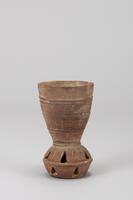
Korean (Korean (culture or style))
Bell Cup (goblet with rattle base)
5th century
Gift of Bruce and Inta Hasenkamp and Museum purchase made possible by Elder and Mrs. Sang-Yong Nam
2004/1.170
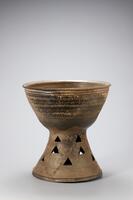
Korean (Korean (culture or style))
Large Pedestal Bowl or Stand
5th century
Gift of Bruce and Inta Hasenkamp and Museum purchase made possible by Elder and Mrs. Sang-Yong Nam
2004/1.179
Loading…
